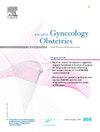Vaginal versus laparoscopic suture for vaginal cuff closure in total robot-assisted laparoscopic hysterectomy: A multicentric comparative study
IF 1.7
4区 医学
Q3 OBSTETRICS & GYNECOLOGY
Journal of gynecology obstetrics and human reproduction
Pub Date : 2025-01-25
DOI:10.1016/j.jogoh.2025.102911
引用次数: 0
Abstract
Background
Vaginal cuff closure is an important step in hysterectomy. To date, the literature and data on this procedure are inconsistent, and the optimal approach (i.e., vaginal or laparoscopic) for closing the vagina at the end of laparoscopic robot-assisted hysterectomy remains unclear. Vaginal cuff complications are rare, but their prevention is an important issue.
Objective
The objective of the present study was to compare early postoperative complications in patients who underwent robot-assisted hysterectomy between the robot-assisted closure group and the transvaginal closure group.
Methods
In this observational, retrospective, multicentre study, patients who underwent total robot-assisted hysterectomy between January 2016 and March 2021 were included. Two groups (robot-assisted and transvaginal closure groups) were compared in terms of the rate of rehospitalization within the first 30 postoperative days, for all causes and for vaginal scar-related complications.
Results
Among the 328 patients included, 185 and 143 underwent robot-assisted and transvaginal closure, respectively. Patients in the transvaginal closure group had a significantly greater risk of rehospitalization for all causes (9.8 % vs. 3.2 %; p = 0.02) and for vaginal cuff complications (8.4 % vs. 2.6 %, p = 0.04). According to the univariate analysis, obesity, HIV infection, blood loss > 500 mL and transvaginal closure were associated with a higher incidence of rehospitalization within 30 days. Multivariate analysis revealed that transvaginal closure (p = 0.01) and obesity (p = 0.03) were significantly associated with a greater risk of rehospitalization.
Conclusion
Compared with transvaginal closure, robot-assisted vaginal closure in robot-assisted total hysterectomy is associated with a reduction in all-cause rehospitalization as well as a reduction in rehospitalization due to vaginal cuff complications. Rates of rehospitalization for vaginal abscess or bleeding could be reduced by avoiding transvaginal closure.
背景:阴道袖带闭合是子宫切除术的重要步骤。迄今为止,有关该手术的文献和数据并不一致,腹腔镜机器人辅助子宫切除术结束时关闭阴道的最佳方法(即阴道或腹腔镜)仍不明确。阴道袖带并发症很少见,但预防并发症是一个重要问题:本研究旨在比较机器人辅助阴道闭合组和经阴道闭合组接受机器人辅助子宫切除术患者的术后早期并发症:在这项观察性、回顾性、多中心研究中,纳入了2016年1月至2021年3月期间接受全机器人辅助子宫切除术的患者。比较了两组(机器人辅助组和经阴道闭合组)术后前30天内因各种原因和阴道疤痕相关并发症再次住院的比例:在328名患者中,分别有185人和143人接受了机器人辅助和经阴道闭合术。经阴道闭合组患者因各种原因(9.8% 对 3.2%;P = 0.02)和阴道袖带并发症(8.4% 对 2.6%;P = 0.04)再次住院的风险明显更高。根据单变量分析,肥胖、HIV 感染、失血量大于 500 毫升和经阴道闭合与 30 天内再次住院的发生率较高有关。多变量分析显示,经阴道闭合(p = 0.01)和肥胖(p = 0.03)与再次住院的风险显著相关:结论:与经阴道闭合术相比,机器人辅助全子宫切除术中的机器人辅助阴道闭合术可降低全因再住院率,并降低因阴道袖带并发症导致的再住院率。避免经阴道闭合术可降低阴道脓肿或出血的再住院率。
本文章由计算机程序翻译,如有差异,请以英文原文为准。
求助全文
约1分钟内获得全文
求助全文
来源期刊

Journal of gynecology obstetrics and human reproduction
Medicine-Obstetrics and Gynecology
CiteScore
3.70
自引率
5.30%
发文量
210
审稿时长
31 days
期刊介绍:
Formerly known as Journal de Gynécologie Obstétrique et Biologie de la Reproduction, Journal of Gynecology Obstetrics and Human Reproduction is the official Academic publication of the French College of Obstetricians and Gynecologists (Collège National des Gynécologues et Obstétriciens Français / CNGOF).
J Gynecol Obstet Hum Reprod publishes monthly, in English, research papers and techniques in the fields of Gynecology, Obstetrics, Neonatology and Human Reproduction: (guest) editorials, original articles, reviews, updates, technical notes, case reports, letters to the editor and guidelines.
Original works include clinical or laboratory investigations and clinical or equipment reports. Reviews include narrative reviews, systematic reviews and meta-analyses.
 求助内容:
求助内容: 应助结果提醒方式:
应助结果提醒方式:


